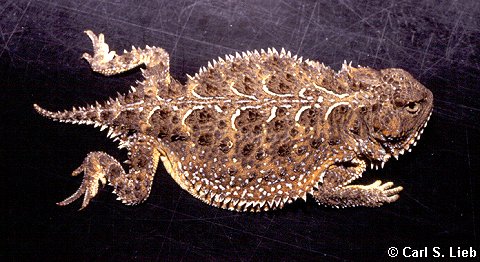
Everyone's heard of horned toads. Unfortunately, though, "toad" is inappropriate—after all, we're talking about lizards, while almost every creature called toad in the common vernacular is an amphibian, as different from lizards as lizards are from birds. Thus, herpetologists insist on using the term "horned lizards"—more correct, if less colorful.
Many people don't distinguish between different kinds of horned
lizards, which is a shame, because about 14 different kinds exist, each unique. The
Chihuahuan Desert boasts of three kinds, filling areas from low desert to woodlands of
mountain islands. Of these, the high-elevation Mountain Short-horned Lizard is of
marginal occurrence, but of considerable interest because it gives birth rather than
laying eggs. Unlike in mammals, the developing young depend on egg yolk for food. Eggs
buried, as by the other species, would not have enough time in the short growing season
for the young to prepare for winter. The mother, basking in the sun, speeds up growth
by the increase in temperature—giving new meaning to the old term of "having
one in the oven". 
Contributor: Arthur H. Harris, Laboratory for Environmental Biology, Centennial Museum, University of Texas at El Paso.
Desert Diary is a joint production of the Centennial Museum and KTEP National Public Radio at the University of Texas at El Paso.

Mountain Short-horned Lizard. Photograph by Carl S. Lieb.